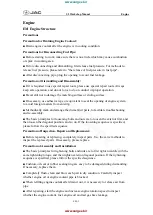
services or spare parts may not be available
immediately. The relevant workshop directories
are available from an authorized Mercedes-Benz
Center.
Fuel
In some countries, only fuels with an increased
sulfur content are available.
Unsuitable fuel can cause engine damage. Infor‐
mation about fuel can be found in the "Fuel" sec‐
tion (
→
page 235).
Information about transport by rail
Transporting your vehicle by rail may be subject
to certain restrictions or require special meas‐
ures to be taken in some countries due to varying
tunnel heights and loading standards.
You can obtain information about this from any
authorized Mercedes-Benz Center.
Notes on brakes
&
WARNING Risk of skidding and of an
accident due to shifting down on slippery
road surfaces
If you shift down on slippery road surfaces to
increase the engine braking effect, the drive
wheels may lose traction.
#
Do not shift down on slippery road sur‐
faces to increase the engine braking
effect.
&
WARNING Risk of accident due to the
brake system overheating
If you leave your foot on the brake pedal
when driving, the brake system may overheat.
This increases the braking distance and the
brake system may even fail.
#
Never use the brake pedal as a footrest.
#
Do not depress the brake pedal and the
accelerator pedal at the same time
while driving.
Downhill gradients
On long and steep downhill gradients you should
observe the following instructions:
R
in vehicles with an automatic transmission,
shift down to shift ranges 2 or 1 in good time
so that the engine is running at a medium to
high engine speed (
→
page 117).
%
Change the shift range in good time when
cruise control is activated. Observe the driv‐
ing tips (
→
page 105).
You thereby make use of the braking effect of the
engine and do not have to brake as often to main‐
tain the speed. This relieves the load on the
service brake and prevents the brakes from over‐
heating and wearing too quickly.
Heavy and light loads
&
WARNING Risk of accident due to the
brake system overheating
If you leave your foot on the brake pedal
when driving, the brake system may overheat.
This increases the braking distance and the
brake system may even fail.
#
Never use the brake pedal as a footrest.
#
Do not depress the brake pedal and the
accelerator pedal at the same time
while driving.
If the brakes have been subjected to a heavy
load, do not stop the vehicle immediately. Drive
on for a short while. The brakes cool down more
quickly in the airflow.
If the brakes have been used only moderately,
you should occasionally test their effectiveness.
To do this, brake more firmly from a higher speed
while paying attention to the traffic conditions.
The brakes will grip better as a result.
Wet road surfaces
If you have been driving for a long time in heavy
rain without braking, there may be a delayed
response when you first apply the brakes. This
may also occur after driving through a car wash
or deep water. You must depress the brake pedal
more firmly. Maintain a longer distance to the
vehicle in front.
While paying attention to the traffic conditions,
you should brake the vehicle firmly after driving
on a wet road surface or through a car wash. This
heats the brake discs so that they dry more
quickly, which protects them against corrosion.
Limited braking effect on salt-treated roads:
R
a layer of salt on the brake discs or brakepads
can increase braking distances considerably,
or braking may happen on only one side
R
maintain an especially large safe distance to
the vehicle in front
108 Driving and parking
Содержание Sprinter 2019
Страница 7: ......
Страница 11: ...NJ Brakes yellow 268 O ABS malfunctioning 268 P ESP deactivated 268 At a glance Instrument cluster 9...
Страница 19: ...ASpare wheel example 227 At a glance Emergencies and breakdowns 17...
Страница 298: ......
















































